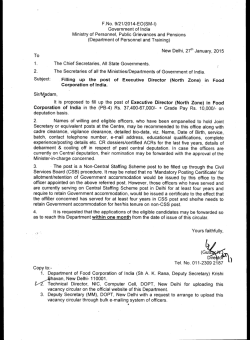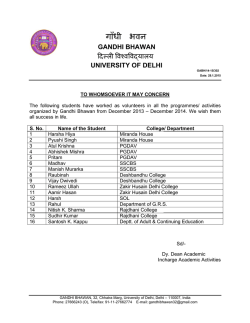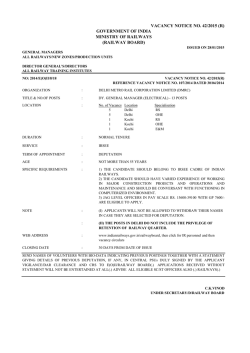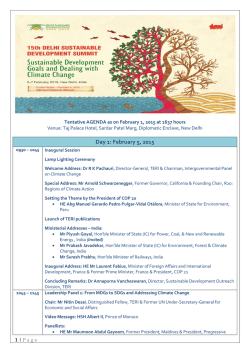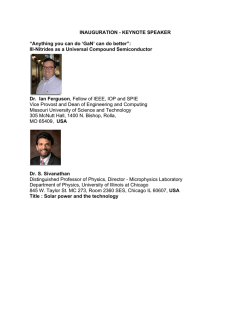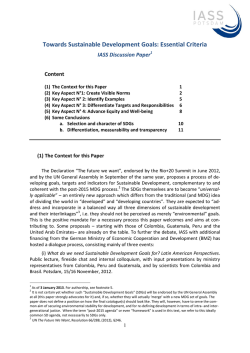
Climate Change Adaptation and Mitigation
Terra reen `50 Subscriber’s copy VOLUME 7 ISSUE 11 EARTH M AT T E R S February 2015 Climate Change Adaptation and Mitigation The SDG Nexus SPECIAL HIGHLIGHTS Turtle Conservation Laxmikant Deshpande Towards Sustainable Agricultural Systems M N Kulkarni IN CONVERSATION Mona Yew oward Director of China Demand-side Management and Energy Efficiency Project s o <2C e s i r e r peratu m e t e verag a l a b glo T JOIN US @ DSDS 2015 HE Mr Kevin Rudd Former Prime Minister of Australia HE Dr Ramos-Horta Former President of East Timor HE Mr Maumoon Abdul Gayoom Former President of Maldives HE Mr Kjell Magne Bondevik Former Prime Minister of Norway HE Mr Ruud Lubbers Former Prime Minister of The Netherlands HE Mr Göran Persson Former Prime Minister of Sweden The Hon. Jean Charest Former Premier of Quebec Dr Henrik O Madsen Group President and CEO, DNV-GL, Norway Mr Paul Polman Chief Executive Officer, Unilever, UK Mr Arnold Schwarzenegger Former Governor, California, USA In the presence of Mr Ban Ki-moon, Secretary General, United Nations, and corporate leaders from DNV-GL • Environmental Financial Products • HCC • HSBC India • Indochina Fund Management Pte Ltd • Nestle • Permian Global Advisors LLP • Ricoh Company Ltd • Shell International ltd • Tata Chemicals • Unilever • Yes Bank Ltd and many more... 15th DELHI SUSTAINABLE DEVELOPMENT SUMMIT Sustainable Development Goals and Dealing with Climate Change February 5–7, 2015, New Delhi, India Curtain Raiser – February 4, 2015 High Level Corporate Dialogue REGISTER NOW For more details: Email: [email protected] | Website: http://dsds.teriin.org EDITORIAL It is essential that between now and Paris, the global community remains engaged, and the two countries responsible for hosting COP20 and COP21, namely Peru and France respectively, continue with their coordinated efforts such that the mildly positive momentum that exists today can actually be enhanced. I t is now over a month since the 20th Conference of the Parties (COP) under the United Nations Framework Convention on Climate Change (UNFCCC) which was held in Lima, Peru. There are mixed feelings and opinions about the success or otherwise of the Conference. The significance that the global community attached to the Lima conference even before it was held, arose from the fact that this COP was supposed to pave the way and provide a framework—and in fact an approved draft—for reaching an agreement in the 21st COP which is to take place in Paris. Some feel that Lima has not really delivered what was expected of that meeting, but many others feel that this was about the best that could have been done. There are some features of the discussion, as well as the final agreement that came from that Conference entitled “Lima call for Climate Action”, which must be seen as a positive development. Lima was after all the 20th Conference of the Parties and to have expected dramatic achievement in this particular meeting, when 19 others have resulted in less than adequate success, would constitute an unrealistic expectation. One of the major observations that most participants, and even the media highlighted, was the fact that most delegations which participated were generally in favour of arriving at a positive resolution of the negotiations, which in the past was not a uniform sentiment, and was seen as much too complex and diverse. The other feature which was noticeable was the frequent and widespread reference to the Fifth Assessment Report (AR5) of the Intergovernmental Panel on Climate Change (IPCC). It appears that most delegates had accepted and absorbed one major message that came out from the AR5, namely, action had to be taken early and in large measure to be able to ensure that temperature increase by the end of the century will not exceed 2oC. They referred extensively to the assessment with numbers and numerous facts to highlight this major inference from the AR5. It is essential that between now and Paris, the global community remains engaged, and the two countries responsible for hosting COP20 and COP21, namely Peru and France, respectively, continue with their coordinated efforts such that the mildly positive momentum that exists today can actually be enhanced. In an ultimate analysis, it is the robust and forthright assessment contained in the AR5 which must determine the completion and the content of an agreement in Paris. It is science that must be the driver of policy in the form of an agreement in Paris. R K Pachauri Director-General, TERI TERRAGREEN FEBRUARY 2015 1 Editor-in-chief R K Pachauri Terra reen MAILBOX `50 Subscriber’s copy VOLUME 7 ISSUE 10 EAR TH MAT TER S January 2015 SPECIAL HIGHLIGHTS Building a Green Mode of Transportation R Navneet Prabhu Applying Gandhian Ideologies to Sustainable Development Samrat Mukherjee Oceans of Energy Does the Future of Energy belong to the Sea? IN CONVERSATION Dr Keryn Gedan Lecturer, University of Maryland, College Park, USA Refer to “Ecosan Toilets Change the Face of Musiri” (TG January, 2015). There is lack of functional toilets in most government schools in India. Slums also lack toilets. The Centre must ensure that washrooms are constructed in government schools. Public toilets that cater to the needs of women must be constructed in the vicinity of slums. One of the chief causes of rape is the absence of bathrooms as women have to step out of their homes to relieve themselves. Public toilets must be cleaned regularly and the poor should not be charged for availing these services. Mahesh Kumar New Delhi Refer to National News “Climate change to hit 46 million hectares of farmland”. Vegetarianism or a climatechange diet can yet save this planet. Human beings in this increasingly materialistic world must ensure that animals and birds are able to live peacefully in their natural habitat. Further, meat with additives can harm the kidneys. Let me quote from Mir Dad’s book, Vegetarian or Non-Vegetarian, Choose Yourself: “He who eats the flesh of any living being shall have to repay it with his own flesh. He who breaks another living being’s bone shall have his own bone smashed”. In other words, non-vegetarians are harming the environment and climate as well. That said, one must concede that eating habits are a very personal matter; every person has right to decide what to eat and what not to eat. Mahesh Kapasi, New Delhi The January 2015 issue of TerraGreen is quite a good read. I liked most of the articles and columns in this issue. The Pioneer section on ecosan toilets is an eye-opener for all of us in other states of the country. I truly feel that the model of ecological sanitation needs to be replicated in several towns and villages of Central India as well. The feature article on green mode of transportation is also fairly engrossing. I apprehend that green transportation is all set to play a vital role in India’s economy. My daughter, who studies in 8th Standard, enjoyed reading the article on water pollution (“Protecting our Water Resources”). With the help of her classmates, she even tried the Activity on creating water cycle, and experienced hands-on & interactive learning. Rohit Shrivastava Bhopal, Madhya Pradesh PRINTED ON RECYCLED PAPER Owned, printed, and published by Dr R K Pachauri for The Energy and Resources Institute, Darbari Seth Block, IHC Complex, Lodhi Road, New Delhi – 110 003, Tel. +91 (11) 2468 2100 or 2468 2111, E-mail [email protected], Fax +91 (11) 2468 2144 or 2468 2145, Web www.teriin.org, and printed by him at Batra Art Press, A-41, Naraina Industrial Area, Phase II, New Delhi-28 © The Energy and Resources Institute. All rights reserved. n es.i ri.r e t ht t p : / / w w w. t e r ra g re e n . t e r i i n . o rg ss@ pre TERRAGREEN FEBRUARY 2015 t2eri Editorial Board Leena Srivastava Rajiv Seth Sangeeta Gupta Publishing Head Anupama Jauhry Editorial Team Anisha Chettri Anushree Tiwari Sharma Abhas Mukherjee Shilpa Mohan Design and Illustration Santosh Gautam and Vijay Nipane Image Editor Shilpa Mohan Production R K Joshi Aman Sachdeva Marketing, Sales & Distribution Gitesh Sinha Kakali Ghosh Lutfullah Syed Rahul Kumar Avinash Kumar Shukla Prashant Sharma Sanjeev Sharma +HDGRIÀFH TERI Darbari Seth Block, IHC Complex Lodhi Road, New Delhi – 110 003 Tel. +91 (11) 2468 2100 or 2468 2111 Fax +91 (11) 2468 2144 or 2468 2145 Regional centres Southern Regional Centre TERI, CA Site No. 2, 4th Main, 2nd Stage Domlur, Bangalore–560 071 Email: [email protected] North-Eastern Regional Centre Chachal Hengrabari, Express Highway Guwahati- 781 036 Tel: 0361-2334790, Fax: 0361-2334869 Email: [email protected] Western Regional Centre House No. 233/GH-2, Vasudha Housing Colony, Alto-St Cruz, Tiswadi, Goa-403 202 Tel: 0832-2459306, 2459328 Email: [email protected] $IÀOLDWHLQVWLWXWHV TERI North America 1152 15th Street NW Suite 300 Washington, DC 20005 Email [email protected] TERI Europe 27 Albert Grove, London SW20 8PZ, UK Email: [email protected] Overseas representation TERI Japan C/o IGES Nippon Press Centre Building (8th Floor) 2-2-1, Uchisaiwai-cho, Chiyodi-ku Tokyo, Japan - 100-0011 E-mail [email protected] TERI South-East Asia Unit 503, 5th Floor Menara Mutiara Majestic 15 Jalan Othman, Seksyen 3, 4600 Petaling Jaya, Selagor Darul Ehsan, Malaysia Email: [email protected] TERI Gulf Centre Flat No. 105, Dalal Building, Al Qusais, Dubai, UAE Contents 4 News 8 TERI Analysis The Awakening Environmental Research Intelligent Facades Generating Electricity, Heat, and Algae Biomass 10 12 18 22 30 34 Feature Towards Sustainable Agricultural Systems VOLUME 7 34 Green Challenges E-Waste Management 37 Terra Youth 48 Maneka Speaks 50 Pioneer 53 Breakthrough 56 Green Events ISSUE 11 12 In Conversation Mona Yew, Director of China Demandside Management and Energy Effieciency Project FEATURE Cover Story Climate Change Adaptation and Mitigation: The SDG Nexus 30 SPECIAL REPORT Special Report Turtle Conservation GREEN CHALLENGES 37 TERRA YOUTH 22 Cover Story FEBRUARY 2015 TERI PUBLICATIONS Why Should I Recycle? … Understand the principle of Reduce, Reuse, and Recycle to ensure that we play our part in making the world a cleaner, healthier, and better place. Pages: 50 Ages:7-10 years Price ` 225 Tells you everything you wanted to know about global warming. It reveals the impact of the increase in greenhouse gases, pollution, and disappearing forests on everyone around the world. Find out why it is important to know about climate change and how we can prevent it. Pages: 30 Ages:11-15 years Price ` 185 An Imprint of TERI Publication for Children Do you know India is among the top 10 bottled water consumers in the world? Or that according to UN estimates, India is on the list of 48 countries that will face water scarcity by 2025? Dive into these pages full of astonishing trivia about the “liquid of life” Pages: 72 Ages:12-14 years 295 Price ` From Roman baths to modern-day space cra crafts, ’ light li ht and we hhave ffoundd ways tto use th the sun’s heat. Yet, even today, we are able to capture only 1 per cent of this energy. Find out how we can make the most of the sun, and why that’s important for our planet. Pages: 30 Ages:11-15 years 150 Price ` For more information, log on to https://bookstore.teri.res.in Cover Story Climate Change Adaptation and Mitigation The SDG Nexus There is a need to pursue strategies and actions towards climate resilient pathways for sustainable development. Dr R K Pachauri discusses the adoption and implementation of the Sustainable Development Goals 22 22 TERRAGREEN TE ER RR RAG AGRE REEN RE EN E N FE FEBRUARY EBR BRUA UA AR RY Y2 2015 01 15 TERRAGREEN TE T ER RR RA AG G GR RE R EE EN N FE FEBRUARY F EBR BRUA ARY R 2015 201 15 23 3 Cover Story A t the Rio+20 Summit held in June 2012, a major document was agreed on under the title “The Future We Want”. A decision was also taken on that occasion to develop a set of goals at the global level which would be called Sustainable Development Goals (SDGs). For this purpose an Open Working Group (OWG) was established by the United Nations General Assembly (UNGA), which developed a set of proposals and submitted them to the Assembly in July 2014. This proposal included 17 goals with 169 targets that covered a range of issues. The SDGs follow on from the acceptance and application, worldwide, of the Millennium Development Goals (MDGs) which were instituted at the beginning of this millennium for the period extending up to 2015. These MDGs have had mixed success, largely effective in some cases, but quite ineffective in others. The MDGs were essentially focussed on reduction of global poverty, which, of course, is a complex and daunting challenge. The SDGs on the other hand aim to transform development into a process that is sustainable under the overall definition of sustainable development, which essentially refers to that form of development which meets the needs of the current generation, without compromising on the ability of future generations to 24 TERRAGREEN FEBRUARY 2015 meet their own needs. The intention is also to build the SDGs to mesh seamlessly with the MDGs and ensure a convergence between the two in the post 2015 development pathway to be followed across the world. In the document produced at Rio+20 it was agreed that the SDGs must be based on Agenda 21 which was agreed on at the first Rio Summit in 1992 as well as the Johannesburg Plan of Implementation which was accepted in 2002. It was expected that the SDGs will fully respect all the Rio principles, be consistent with international law, and build upon commitments already made. The process defined in “The Future We Want” and followed by the UN established an inclusive and transparent intergovernmental process on the SDGs that was open to all stakeholders with the intention of developing global SDGs to be agreed on finally by the UNGA. The OWG highlighted the fact that the global nature of climate change calls for the widest possible cooperation by all the countries and that their participation in an effective and appropriate international response was called for with a view to hastening the reduction of global greenhouse gas (GHG) emissions. It referred to the United Nations Framework Convention on Climate Change (UNFCCC), which provides that parties should protect the climate system for the benefit of present and future generations, and that this be done on the basis of equity and in accordance with their common but differentiated responsibilities and respective capabilities. It also noted, with grave concern, the major gap between the aggregate effect of mitigation pledges by parties in terms of global annual emissions of GHGs by 2020 and aggregate emission pathways consistent with having a likely chance of holding the increase in global average temperature below 2oC or 1.5oC above pre-industrial levels. It further reaffirmed that the ultimate objective under the UNFCCC is to stabilize GHG concentrations in the atmosphere at a level that would prevent dangerous anthropogenic interference with the climate system. The UNFCCC contains in its Article 2, further elaboration of what would constitute dangerous anthropogenic interference. It states, “Such a level should be achieved within a time-frame sufficient to allow ecosystems to adapt naturally to climate change, to ensure that food production is not threatened and to enable economic development to proceed in a sustainable manner”. The determination of these conditions which may provide an understanding of the level which constitutes dangerous anthropogenic interference clearly depends on value judgements and the application of certain principles involving equity and ethics. In the year 2015, two major areas of human endeavour are likely to reach important culmination. The first is, of course, the adoption and implementation of the SDGs which are currently under preparation and the second relates to a global agreement on climate change which is expected to be reached at the next Conference of the Parties in Paris at the end of this year. Any agreement in dealing with the challenge of climate change has to be based on the comprehensive scientific assessment provided by the Intergovernmental Panel on Climate Change (IPCC) in its Fifth Assessment Report (AR5) which was completed with the release of its Synthesis Report in early November 2014. Undoubtedly, the AR5 clearly provided an important frame of reference in the discussions and negotiations that took place at the 20th Conference of the Parties held in Lima in December 2014. However, there are some key messages based on the assessment contained in the AR5, which must now guide the global community in arriving at a global agreement in the 21st Conference of the Parties in Paris. Some of these key messages are provided below. • Human influence on the climate system is clear, and recent anthropogenic emissions of GHGs are the highest in history. Recent climate changes have had widespread impacts on human and natural systems. • Warming of the climate system is unequivocal, and since the 1950s, many of the observed changes are unprecedented over decades to millennia. The atmosphere and ocean have warmed, the amounts of snow and ice have diminished, and sea level has risen. Anthropogenic GHG emissions have increased since the pre-industrial era, driven largely by economic and population growth, and are now higher than ever before. This has led to atmospheric concentrations of carbon dioxide, methane, and nitrous oxide that are unprecedented in at least the last 800,000 years. Their effects, together with those of other anthropogenic drivers, have been detected throughout the climate system and are extremely likely to have been the dominant cause of the observed global warming since the mid-20th century. TERRAGREEN FEBRUARY 2015 25 Cover Story • In recent decades, changes in climate have caused impacts on natural and human systems on all continents and across the oceans. These impacts are due to observed climate change, irrespective of its cause, indicating the sensitivity of natural and human systems to the changing climate. • Changes in many extreme weather and climate events have been observed since about 1950. Some of these changes have been linked to human influences, including a decrease in cold temperature extremes, an increase in warm temperature extremes, an increase in extreme high sea levels, and an increase in the number of heavy precipitation events in a number of regions. • Continued emission of GHGs will cause further warming and long-lasting changes in all components of the climate system, increasing the likelihood of severe, pervasive, and irreversible impacts for people and ecosystems. Limiting climate change would require substantial and sustained reductions in GHG emissions which, together with adaptation, can limit climate change risks. • Cumulative emissions of CO2 largely determine global mean surface warming by the late 21st century and beyond. Projections of GHG emissions 26 TERRAGREEN FEBRUARY 2015 • • • • vary over a wide range, depending on both socioeconomic development and climate policy. Surface temperature is projected to rise over the 21st century under all assessed emission scenarios. It is very likely that heat waves will occur more often and last longer, and that extreme precipitation events will become more intense and frequent in many regions. The ocean will continue to warm and acidify, causing the global mean sea level to rise. Climate change will amplify existing risks and create new risks for natural and human systems. Risks are unevenly distributed and are generally greater for disadvantaged people and communities in countries at all levels of development. Many aspects of climate change and associated impacts will continue for centuries, even if anthropogenic emissions of GHGs are stopped. The risks of abrupt or irreversible changes increase as the magnitude of warming increases. Adaptation and mitigation are complementary strategies for reducing and managing the risks of climate change. Substantial emissions reductions over the next few decades can reduce climate risks in the 21st century and beyond, increase prospects for effective adaptation, reduce the costs • • • • • • and challenges of mitigation in the longer term, and contribute to climate-resilient pathways for sustainable development. Effective decision making to limit climate change and its effects can be informed by a wide range of analytical approaches for evaluating expected risks and benefits, recognizing the importance of governance, ethical dimensions, equity, value judgments, economic assessments and diverse perceptions, and responses to risk and uncertainty. Without additional mitigation efforts beyond those in place today, and even with adaptation, warming by the end of the 21st century will lead from high to very high risk of severe, widespread, and irreversible impacts globally (high confidence). Mitigation involves some level of co-benefits and of risks due to adverse side-effects, but these risks do not involve the same possibility of severe, widespread, and irreversible impacts as risks from climate change, thereby increasing the benefits from near-term mitigation efforts. Adaptation can reduce the risks of climate change impacts, but there are limits to its effectiveness, especially with greater magnitudes and rates of climate change. Taking a longer-term perspective, in the context of sustainable development, increases the likelihood that more immediate adaptation actions will also enhance future options and preparedness. There are multiple mitigation pathways that are likely to limit warming to below 2°C relative to pre-industrial levels. These pathways would require substantial emission reductions over the next few decades and near zero emissions of CO2 and other long-lived GHGs by the end of the century. Implementing such reductions poses substantial technological, economic, social, and institutional challenges, which increase with delays in additional mitigation and unavailability of key technologies. Limiting warming to lower or higher level involves similar challenges, but on different timescales. Many adaptation and mitigation options can help address climate change, but no single option is sufficient by itself. Effective implementation depends on policies and cooperation at all scales, and can be enhanced through integrated responses that link adaptation and mitigation with other societal objectives. Adaptation and mitigation responses are underpinned by common enabling factors. These include effective institutions and governance, innovation and investments in environmentally sound technologies and infrastructure, sustainable livelihoods, and behavioural and lifestyle choices. • Adaptation options exist in all sectors, but their context for implementation and potential to reduce climate-related risks differ across sectors and regions. Some adaptation responses involve significant co-benefits, synergies, and trade-offs. Increasing climate change will increase challenges for many adaptation options. • Mitigation options are available in every major sector. Mitigation can be more cost-effective by using an integrated approach that combines measures to reduce energy use and the GHG intensity of endues sectors, decarbonize energy supply, reduce net emissions, and enhance carbon sinks in land-based sectors. • Effective adaptation and mitigation responses will depend on policies and measures across multiple scales: regional, sub-national, national, and international. Policies across all scales supporting technology development, diffusion and transfer, as well as finance for responses to climate change, can complement and enhance the effectiveness of policies that directly promote adaptation and mitigation. Since mitigation reduces the rate as well as the magnitude of warming, it also increases the time available for adaptation to a particular level of climate change, potentially by several decades. Delaying mitigation actions may reduce options for climateresilient pathways in the future. Strategies and actions can be pursued now, which will move towards climate resilient pathways for sustainable development, while TERRAGREEN FEBRUARY 2015 27 Cover Story at the same time helping to improve livelihoods, social, and economic well-being, and responsible environmental management. At the national level, transformation is considered most effective when it reflects a country’s own visions and approaches to achieving sustainable development in accordance with its national circumstances and priorities. Transformations to sustainability are considered to benefit from iterative learning, deliberative processes, and innovation. Hence, it can be seen that action to deal with climate change overlaps substantially with actions required to move society towards a path of sustainable development. At the international level, therefore, devising a set of SDGs is particularly challenging, because these must not only recognize and deal with climate change, both in respect of adaptation and mitigation, but they must also take into account national priorities and concerns. To come up with universally acceptable and applicable goals, the SDGs must necessarily take into account sensitivities at the national level arising out of ethical considerations and equity aspects of actions implied. But they must also include linkage with the MDGs, the intent and thrust of which cannot be abandoned in developing a new set of goals called the SDGs. It is imperative that the SDGs bring about adequate telescoping with and a seamless transition from the MDGs. It is for this reason that the process and pathway for developing the SDGs is proving to be complex and time-consuming. And, it is totally in order that the UNGA, rather than any other institution, should take on 28 TERRAGREEN FEBRUARY 2015 this task following on from the Rio +20 Summit and all the earlier international agreements and discussions, because it is only in the forum of the UNGA that every nation would have an opportunity to express its priorities and concerns. The UNGA is also the right body for taking into account all aspects of actions to deal with climate change without in any way interfering with the process ongoing under the UNFCCC. The year 2015 is, therefore, presenting to the global community an unprecedented challenge because not only does this year require the formulation and acceptance of the SDGs by the middle of the year but also the conclusion of a global agreement to deal with climate change by the end of the year. And, the former will have to be completed well before the 21st Conference of the Parties to be held in Paris under the UNFCCC, where it is expected that a global agreement will be reached on climate change. It is, therefore, particularly important that the question of what should constitute the SDGs must also take into account the actions that should emanate from a global agreement to tackle climate change. And every discussion and forum in this general field that takes place in the coming months must take on board, a consideration of SDGs only in conjunction with what should constitute an effective agreement on climate change and vice versa.# Dr R K Pachauri, Director-General, The Energy and Resources Institute (TERI) and Chairman, Intergovernmental Panel on Climate Change (IPCC). A Publication JUST RELEASED CARBON CAPTURE, STORAGE, AND UTILIZATION A possible climate change solution for energy industry Editors Malti Goel, M Sudhakar, and R V Shahi 2015 • ISBN: 9788179935682 Pages: 290 • Binding: Hardback Size: 180 × 240 mm • Price: `950.00 Carbon capture and storage (CCS) is among the advanced energy technologies suggested to make the conventional fossil fuel sources environmentally sustainable. It is of particular importance to coal-based economies. Carbon Capture, Storage, and Utilization deals at length with the various aspects of carbon dioxide capture, its utilization and takes a closer look at the earth processes in carbon dioxide storage. It discusses potential of carbon capture, storage, and utilization as innovative energy technology towards a sustainable energy future. Various techniques of carbon dioxide recovery from power plants by physical, chemical, and biological means as well as challenges and prospects in biomimetic carbon sequestration are described. Carbon fixation potential in coal mines and in saline aquifers is also discussed. Key Features • Analyses how current research on carbon capture, storage, and utilization is being pursued throughout the world. • Presents details of earth process in carbon sequestration such as saline aquifers, minerals, rocks, and coal mines. • Describes the new cost-effective processes being developed in carbon dioxide utilization for value-added products. The Energy and Resources Institute Attn: TERI Press Darbari Seth Block IHC Complex, Lodhi Road New Delhi – 110 003/India Tel. 2468 2100 or 4150 4900 Fax: 2468 2144 or 2468 2145 India +91 • Delhi (0)11 Email: [email protected] Web: http://bookstore.teriin.org To purchase the book, visit our online bookstore at http://bookstore.teriin.org or send us your demand draft or cheque in favour of TERI, payable at New Delhi (outstation cheques are not accepted). Info bytes Recycling astronaut urine for energy and drinking water On the less glamorous side of space exploration, there’s the more practical problem of waste—in particular, what to do with astronaut urine. Rather than ejecting it into space, scientists are developing a new technique that can turn this waste into a boon by converting it into fuel and much-needed drinking water. The scientists collected urine and shower wastewater and processed it using forward osmosis, a way to filter contaminants from urea, a major component of urine and water. Their new Urea Bioreactor Electrochemical (UBE) system efficiently converted the urea into ammonia in its bioreactor, and then turned the ammonia into energy with its fuel cell. Source: www.sciencedaily.com Do viruses make us smarter? A new study from Lund University in Sweden indicates that inherited viruses that are millions-of-years old play an important role in building up the complex networks that characterize the human brain. They have found that retroviruses seem to play a central role in the basic functions of the brain, more specifically in the regulation of which genes are to be expressed, and when. Researchers have long been aware that endogenous retroviruses constitute around five per cent of our DNA. The findings indicate that, the reason the viruses are activated specifically in the brain is probably due to the fact that tumours cannot form in nerve cells, unlike in other tissues. Source: www.sciencedaily.com To know more... Read GREEN GENIUS’S 101 QUESTIONS AND ANSWERS CLEAN, GREEN TECHNOLOGY Aparajita Kashyap Scientists have been exploring, designing, and discovering new technologies that will leave our environment intact instead of destroying it. Energy from the shining sun, flowing waters, and the open windy spaces can now be used to run our cars and light up our homes. These non-polluting sources of energy are clean, earth-friendly, and absolutely free. Increase your green quotient and learn the answers to some less frequently asked questions on green technology. Join Green Genius as he introduces you to environment-friendly technologies and gadgets. Buy online: http://bookstore.teri.res.in or amazon.in 46 TERRAGREEN FEBRUARY 2015 Terra reen Ear th MAT TERS Terraa reenn Rs 40 Subscriber’s copy VOLUME 4 ISSUE 1 APRIL 2011 The “G-quotient” of the Union Budget 2011/12 Paving the way Providing safe access for wildlife in Lumding Reserve Forest E ARTH MATTE RS The healing herbs of India TerraGreen promotes the concept of sustainable development. Launched in June 2004, this magazine from TERI is an effort to bring forth information and knowledge in the fields of energy, environment, and sustainable development. The magazine is in keeping with our mission to expand the base of environmentally conscious readers and popularize sustainability issues at the local level. TerraGreen aims to provide the readers with the necessary inputs to enable them to be a part of the process of change. The magazine stays away from all jargon, so that the educated, informed, yet lay readers are updated on all that happens around them everyday. Real problems, real solutions IN CONVERSATION Hameed Ullah Jan Afridi Minister for Environment, Pakistan Supported by Tick one Term (yrs) No. of issues Cover price ` USD You pay ` You save ` USD per cent saving USD 1 12 600 120 540 102 60 18 10 2 24 1200 240 1020 192 180 48 15 3* 36 1800 360 1440 252 380 108 20 * Free online access to those subscribing for 3 years Customer Code...................................................................(in case of renewal) ..................................................................................................................................... Name of the Customer (IN BLOCK LETTERS)........................................................................................................................................................................................ Designation............................................ Company / Organization........................................................................................................................................................... City..................................................... State........................................................PIN.......................................................Country............................................................ Email........................................................................................................................................................................................................................................................ IF YOU WANT TO GIFT A SUBSCRIPTION Name.....................................................................................................................................................Contact No................................................................................. Address:................................................................................................................................................................................................................................................... City......................................................... State.......................................................... PIN........................................... Country................................................................. Contact No......................................................Email............................................................................................................................................................................... PAYMENT PROCEDURE Enclosed a Cheque/Draft number.............................................................................................................................drawn in favour of ‘TERI’ payable at New Delhi for `/.................................................................................................................for 1/2/3/ year subscription of TerraGreen. Buy online at http://bookstore.teriin.org FOR SUBSCRIPTION QUERIES CONTACT Gitesh Sinha, Marketing Manager, e-mail: [email protected] Kakali Ghosh, Asst. Executive (Marketing), e-mail: [email protected] THE ENERGY AND RESOURCES INSTITUTE Darbari Seth Block, IHC Complex, Lodhi Road, New Delhi – 110 003 Tel. 2468 2100 or 4150 4900, Fax 2468 2144 or 2468 2145, India +91 • Delhi (0) 11 www.terragreen.teriin.org TERRAGREEN SEPTEMBER 2011 55 The Energy and Resources Institute Terra reen EA RT H MA T TER S FEEDBACK FORM PLEASE TICK YOUR CHOICE. 1. Which section(s) did you find the most interesting? G TERI Analysis G Environmental Research G Feature G In Conversation (Interview) G Cover Story G Special Report G Green Challenges G Terra Youth G Review FEBRUARY 2015 5th International Conference on Climate Change and Sustainable Management of Natural Resources February 9–11, 2015 Gwalior, Madhya Pradesh, India http://event.itmuniversity.ac.in/AcademicEvents/TIMS/ 2nd International Conference on “Applied Sciences, Environmental Engineering, and Energy Technology for Sustainable Development” (ASET-2015) February 14–15, 2015 New Delhi, Delhi, India http://www.krishisanskriti.org/applied.html International Congress on “Role of Agri-Science, Forestry, Food Technology, and Participatory Natural Resource Management for Mitigation of Climate Change” (AF-Nature2015) February 21–22, 2015 New Delhi, Delhi, India http://www.krishisanskriti.org/afbc.html International Conference on Advanced Engineering and Technology for Sustainable Development (AETSD 2015) March 5–6, 2015 56 Coimbatore, Tamil Nadu, India http://www.kceicaetsd.com 2. In your opinion, which section(s) need(s) improvement? G TERI Analysis G Environmental Research G Feature G In Conversation (interview) G Cover Story G Special Report G Green Challenges G Terra Youth G Review 3. What do you think about the look and feel of TerraGreen? G Brilliant G Design is not a priority, content is G Average G Needs improvement 4. In your opinion, what aspect(s) of TerraGreen need(s) improvement? G Choice of stories G Handling of issues G Language G Design G Presentation 5. Please rate TerraGreen on a scale of 1–5 (5 being the best). G 1G 2G 3G 4G 5 6. What issues would you like TerraGreen to cover? .......................................................................................................................... ................... .............................................................................................................................................. 7. Which other environmental magazine(s) do you read? .......................................................................................................................G None 8. Any further suggestions? ............................................................................................................................................ ............................................................................................................................................ YOUR DETAILS Name: ...................................................................................................................................... Profession:........................................................................................................................... Tel: ............................................................................................................................................ E-mail: ..................................................................................................................................... The most innovative suggestion will get a suprise gift. The Energy and Resources Institute Attn: TERI Press Darbari Seth Block IHC Complex, Lodhi Road New Delhi – 110 003/India Tel. 2468 2100 or 4150 4900 Fax: 2468 2144 or 2468 2145 India +91 • Delhi (0)11 Email: [email protected] Web: http://bookstore.teriin.org February 2015 One year `540 / $102 • Two years `1020 / $192 • Three years `1440 / $252 (Free online access for those subscribing for three years) Gitesh Sinha Email: [email protected] <Extn 2718> Kakali Ghosh Email: [email protected] <Extn 2736> Sangeeta Paul Email: [email protected] <Extn 2734> Postal Regn. No. DL(S)-17/3328/2014-16 RNI No. DELENG/2008/24157 ISSN No. 0974-5688 Posted on 5–6 February 2015 %\/RGKL5RDG3RVW2I¿FH No. of Pages 56 without Cover Books on Environmental Research and Sustainable Development Order your copy today TERI publications also available at bookstore For more information, log on to http://bookstore.teriin.org
© Copyright 2026
